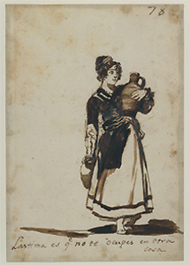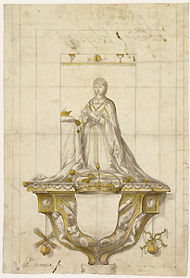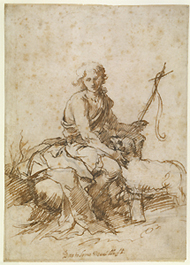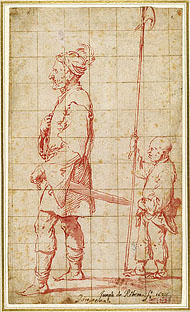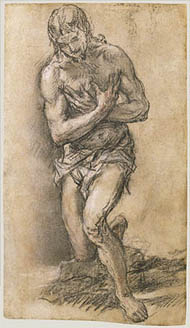
 |
 |
Christ Baptized, about 1682
Juan Carreño de Miranda
Recent Acquisition
|
 |
 |
|
|
 |
Juan Carreño de Miranda received his early training in Madrid, the capital of Spain and its most active and significant artistic center. He later collaborated frequently with Spanish artists working in the Italian style.
Carreño made this figure study in preparation for his painting Baptism of Christ (now in the parish church of Santiago, Madrid). The rich layering of charcoal and red and white chalk that models the muscular figure of Christ demonstrates the influence of the Renaissance Venetian master, Titian. Distinctly Spanish, however, is the rough application of dark charcoal, especially in the outlines, that lends the form starkness and drama. This evocative drawing epitomizes Carreño's distinctive fusion of Venetian and Spanish elements.
|
 |
|
Francisco José de Goya y Lucientes has been called the first modern artist. While most famous for his large oil paintings produced for powerful patrons, Goya created art for his own enjoyment on a scale unprecedented at the time: his private albums included some 550 drawings, created over a 60-year career. Five drawings in this exhibition give an idea of the scope of his subject matter and the brilliance of his spontaneous technique, which sets up a lively interplay between the figures and the blank ground of the paper.
Here, a Spanish beauty carries water jugs. Goya's title, Lastima es q.e no te òcupes en otra/cosa (It's a pity you don't have something else to do), may contain sexual innuendo, as the water carrier was traditionally associated with broken pots and lost virginity.
|
 |
|
Pedro Mena y Medrano was one of the most well-known makers of religious images in Andalusia, a region in the South of Spain. His polychrome wood statues of Queen Isabella and King Ferdinand, who ruled Spain together some two centuries earlier, were commissioned by the cathedral of Granada.
This important drawing is the modello, or contractual drawing, for the statue of Queen Isabella. The patrons reviewed the modello and signed it on the back in agreement to the design. Shown in prayer, Isabella is commemorated here as a devout Catholic monarch.
|
 |
|
The bold penwork and vigorous parallel lines Bartolomé Esteban Murillo used in this drawing show the legacy of draftsmanship in Seville, in the South of Spain. The method of using parallel lines or a network of intersecting lines to indicate shading refers to the technique established by Murillo's teacher, Juan del Castillo, whose drawings are also in this exhibition.
The harsh contrast of light and dark lends this touching biblical scene between the youthful Saint John and the lamb poignant significance. The lamb and the cross-shaped staff symbolize Christ's sacrifice as foretold in the Book of John when "John looked towards Jesus and said, 'Behold the Lamb of God.'"
|
 |
|
Jusepe de Ribera received his training in Valencia, a region in eastern Spain. By the 1500s Valencia was thriving, with close economic and artistic links to other parts of Europe, especially Italy. In 1616, Ribera permanently relocated to Naples, then a Spanish territory (today part of Italy). A prolific draftsman, he used pen and ink to create some of his most imaginative and spirited compositions.
This caricature depicts a pompous and disheveled nobleman and his ragged, diminutive lackey, both given mockingly serious expressions. The brightly colored ink was probably made from the dried bodies of the cochineal insect, a beetle found in Mexico. During Ribera's time, Spaniards called these valuable insects "the scarlet grain" and imported them to Europe.
|
 |

